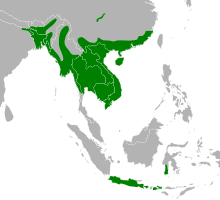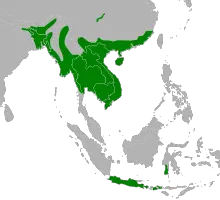The Burmese Python is a massive snake that can grow up to 23 feet long and weigh over 200 pounds. This species is native to Southeast Asia, specifically in countries like Myanmar, Thailand, and Indonesia.
However, Burmese Pythons have also been introduced to other parts of the world, such as the United States. In Florida, for example, Burmese Pythons have become an invasive species that threatens the local ecosystem. So, where exactly can you find these giant snakes? Let’s explore the answer to that question.

Where is the Burmese Python Located?
Burmese pythons are one of the largest species of snakes in the world. They are found in Southeast Asia, including Myanmar, Thailand, and Vietnam. In recent years, they have become an invasive species in Florida, where they are causing harm to the local ecosystem.
Native Range of Burmese Pythons
Burmese pythons are native to the tropical and subtropical regions of Southeast Asia. They are found in countries such as Myanmar, Thailand, and Vietnam. In these areas, they inhabit a range of habitats, including forests, grasslands, and swamps. They are excellent swimmers and can even live in water.
In their native range, Burmese pythons play an important role in the ecosystem as top predators. They feed on a variety of prey, including rodents, birds, and other reptiles. They also help to control the populations of these animals.
Invasive Species in Florida
In recent years, Burmese pythons have become an invasive species in Florida. It is believed that they were introduced to the state by pet owners who released them into the wild. Since then, their population has exploded, and they are causing harm to the local ecosystem.
In Florida, Burmese pythons are found in the Everglades National Park and surrounding areas. They feed on a variety of native species, including birds, mammals, and reptiles. They are also known to compete with native predators such as alligators and panthers for food.
Impact on the Ecosystem
Burmese pythons are having a significant impact on the ecosystem in Florida. They are preying on native species at an alarming rate, which is causing a decline in their populations. This, in turn, is affecting other species that depend on them for food.
The presence of Burmese pythons is also altering the food web in the region. With their large size and predatory nature, they are changing the dynamics of the ecosystem. This can have long-term effects on the environment and the species that live there.
Efforts to Control the Population
Efforts are underway to control the population of Burmese pythons in Florida. One method being used is to capture and remove them from the wild. This is being done by both professionals and volunteers.
Another approach is to use technology to track and locate Burmese pythons. This includes the use of radio transmitters and GPS devices. By tracking their movements, researchers can better understand their behavior and develop strategies for controlling their population.
Benefits of Burmese Pythons
While Burmese pythons are causing harm in Florida, they do have some benefits in their native range. As top predators, they help to control the populations of other animals. This can help to maintain a healthy ecosystem and prevent overgrazing or other imbalances.
In addition, Burmese pythons have cultural significance in some areas of Southeast Asia. They are used in traditional medicine and are also kept as pets. For some people, they are a source of income through the sale of their skins and other parts.
Vs Other Python Species
Burmese pythons are often compared to other species of pythons, such as the reticulated python and the African rock python. While they share some similarities, there are also important differences between them.
Burmese pythons are generally larger than other python species, with some individuals reaching lengths of over 20 feet. They also have a distinctive pattern of dark brown patches on a lighter background. In contrast, reticulated pythons have a more intricate pattern of lines and dots, while African rock pythons have a more uniform coloration.
Legal Status
The legal status of Burmese pythons varies depending on the country and region. In their native range, they are protected under various laws and regulations. However, in some areas, they are still hunted for their meat and other parts.
In the United States, Burmese pythons are considered an invasive species and are illegal to own as pets in many states. In Florida, it is illegal to release them into the wild or transport them across state lines without a permit.
Conclusion
Burmese pythons are fascinating creatures with a complex role in the ecosystems of Southeast Asia. However, their introduction to Florida has had devastating effects on the local environment. Efforts are underway to control their population and prevent further harm. Understanding more about these creatures can help us to protect the environments they inhabit and prevent the spread of invasive species.
Frequently Asked Questions
Here are some common questions and answers about where the Burmese Python can be found:
Where is the Burmese Python located?
The Burmese Python is a large non-venomous snake that is native to Southeast Asia, specifically in countries such as Myanmar, Thailand, Indonesia, and Vietnam. They are also found in other parts of the world where they have been introduced as a non-native species, including the United States. In Southeast Asia, these snakes can be found in a variety of habitats, including forests, grasslands, and marshes.
In the United States, Burmese Pythons can be found in Florida, particularly in the Everglades National Park. These snakes were likely introduced to the area as pets that were released into the wild and have since become an invasive species, causing harm to the local ecosystem.
What is the habitat of the Burmese Python?
The Burmese Python is a very adaptable species, and can be found in a variety of habitats. In Southeast Asia, they are commonly found in forests, grasslands, and marshes. They are also known to inhabit agricultural areas and even urban areas.
In the United States, Burmese Pythons are primarily found in the Everglades National Park in Florida. They prefer to live in wetland areas, including swamps, marshes, and river floodplains. They are also known to inhabit hardwood hammocks, which are elevated areas of forest that are surrounded by wetlands.
How big can the Burmese Python grow?
The Burmese Python is one of the largest snakes in the world, and can grow to be over 20 feet long in some cases. They are also very heavy, with some individuals weighing over 200 pounds. Females tend to be larger than males, and can lay clutches of up to 100 eggs.
In the United States, Burmese Pythons are known to grow to be over 16 feet long and weigh over 100 pounds. They are a threat to local wildlife due to their size and ability to consume large prey.
What do Burmese Pythons eat?
The Burmese Python is a carnivorous species, and primarily feeds on small mammals, birds, and reptiles. They are known to be opportunistic hunters, and will consume almost any prey they can catch. In Southeast Asia, they have been known to eat monkeys, deer, and even small tigers.
In the United States, Burmese Pythons are a threat to local wildlife due to their ability to consume large prey. They have been known to eat animals such as alligators, deer, and even panthers.
Are Burmese Pythons dangerous to humans?
The Burmese Python is not considered to be a significant threat to humans. They are non-venomous and generally not aggressive towards humans unless they feel threatened or cornered. However, they are a threat to pets and livestock, and can cause harm to local ecosystems when they are introduced as a non-native species.
In the United States, there have been some reports of Burmese Pythons attacking humans, but these incidents are rare. It is important for people to be cautious around these snakes and to not approach them in the wild.
Largest Burmese python in Florida history discovered in the Everglades
In conclusion, the Burmese Python is a notorious species that has made its home in various regions across the globe. However, its native habitat is Southeast Asia, specifically in areas such as Thailand, Myanmar (formerly known as Burma), and Indonesia.
Due to their adaptability, Burmese Pythons have also been introduced to other parts of the world, including Florida in the United States. They have caused significant ecological damage in these regions, which has sparked concerns among conservationists and wildlife experts.
Despite their reputation as a formidable predator, these snakes are fascinating creatures that have captivated the interest of many. If you’re interested in observing them in their natural habitat, it’s best to visit Southeast Asia, where you can catch a glimpse of these massive serpents in action.


